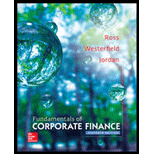
a)
To compute: The value of Publication IR to Company B.
Introduction:
Merger is the complete absorption of one company by another company. The acquiring company acquires all the assets and liabilities of the acquired firm and acquiring firm retains its name and identity. The acquired firm ceases to exist as a separate business entity after a merger.
a)
Answer to Problem 14QP
The value of Publications I to Company B is $9,857,250.
Explanation of Solution
Given information:
“Company B” is analysing the purchase of “Publications I”. Company B expects that earnings and dividends of Publications I to grow at a constant rate of 5% every year. Because of synergy, Company B’s growth rate will increase to 7% each year.
The price earnings ratio of Company B and Publications I are 14.5% and 9.2% respectively. The outstanding shares of Company B and Publications I are $1,400,000 and $195,000 respectively. The earnings of Company B and Publications I are $4,300,000 and $705,000 respectively and the dividends of Company B and Publications I are $1,075,000 and $375,000 respectively.
Formula to calculate the value of Publications I to Company B:
Calculate the value of Publications I to Company B:
Hence, the value of Publications I to Company B is $3.61538 per share.
Formula to calculate the share price of Target Company (I Publications):
Calculate the share price of Target Company (I Publications):
Hence, the share price of the target company is $33.261496.
Formula to calculate the dividend per share:
Calculate the dividend per share:
Hence, the dividend of Publications I is $1.923.
Formula to calculate the required
Calculate the required rate of return for the target company’ shareholders:
Hence, the required return of Publications I is 11.07%.
Formula to calculate the share price of the target company with new growth rate:
Calculate the share price of the target company with new growth rate:
Hence, the share price of the target company is $50.55.
Formula to calculate the value of Publications I to Company B:
Calculate the value of Publications I to Company B:
Hence, the value of Publications I to Company B is $9,857,250.
b)
To compute: The gain of Company B from the acquisition.
Introduction:
Merger is the complete absorption of one company by another company. The acquiring company acquires all the assets and liabilities of the acquired firm and acquiring firm retains its name and identity. The acquired firm ceases to exist as a separate business entity after a merger.
b)
Answer to Problem 14QP
Company B’s gain from acquisition is $3,371,258.28.
Explanation of Solution
Given information:
“Company B” is analysing the purchase of “Publications I”. Company B expects that earnings and dividends of Publications I to grow at a constant rate of 5% every year. Because of synergy, Company B’s growth rate will increase to 7% each year.
The price earnings ratio of Company B and Publications I are 14.5% and 9.2% respectively. The outstanding shares of Company B and Publications I are $1,400,000 and $195,000 respectively. The earnings of Company B and Publications I are $4,300,000 and $705,000 respectively and the dividends of Company B and Publications I are $1,075,000 and $375,000 respectively.
Formula to calculate Company B’s gain from the acquisition:
Calculate Company B’s gain from the acquisition:
Hence, Company B’s gain from acquisition is $3,371,258.28.
c)
To compute: The
Introduction:
Merger is the complete absorption of one company by another company. The acquiring company acquires all the assets and liabilities of the acquired firm and acquiring firm retains its name and identity. The acquired firm ceases to exist as a separate business entity after a merger.
c)
Answer to Problem 14QP
The NPV of the acquisition is $2,447,250.
Explanation of Solution
Given information:
“Company B” is analysing the purchase of “Publications I”. Company B expects that earnings and dividends of Publications I to grow at a constant rate of 5% every year. Because of synergy, Company B’s growth rate will increase to 7% each year.
The price earnings ratio of Company B and Publications I are 14.5% and 9.2% respectively. The outstanding shares of Company B and Publications I are $1,400,000 and $195,000 respectively. The earnings of Company B and Publications I are $4,300,000 and $705,000 respectively and the dividends of Company B and Publications I are $1,075,000 and $375,000 respectively.
Formula to calculate the NPV of the acquisition, if Company B offers $38 in cash for each share of Publications I:
Calculate the NPV of the acquisition, if Company B offers $38 in cash for each share of Publications I.
Hence, the NPV of the acquisition at $38 offer price is $2,447,250.
d)
To compute: The maximum bidding price that Company B will be willing to pay for Publications I.
Introduction:
Merger is the complete absorption of one company by another company. The acquiring company acquires all the assets and liabilities of the acquired firm and acquiring firm retains its name and identity. The acquired firm ceases to exist as a separate business entity after a merger.
d)
Answer to Problem 14QP
The maximum bid price is $50.55.
Explanation of Solution
Given information:
“Company B” is analysing the purchase of “Publications I”. Company B expects that earnings and dividends of Publications I to grow at a constant rate of 5% every year. Because of synergy, Company B’s growth rate will increase to 7% each year.
The price earnings ratio of Company B and Publications I are 14.5% and 9.2% respectively. The outstanding shares of Company B and Publications I are $1,400,000 and $195,000 respectively. The earnings of Company B and Publications I are $4,300,000 and $705,000 respectively and the dividends of Company B and Publications I are $1,075,000 and $375,000 respectively.
Formula to calculate the maximum bid price:
Hence, Company B’s maximum bid price is $50.55.
e)
To compute: The NPV of the acquisition, if Company B was offered $205,000 of its shares for the stock outstanding of Publications I.
Introduction:
Merger is the complete absorption of one company by another company. The acquiring company acquires all the assets and liabilities of the acquired firm and acquiring firm retains its name and identity. The acquired firm ceases to exist as a separate business entity after a merger.
e)
Answer to Problem 14QP
The NPV is $634,300.
Explanation of Solution
Given information:
“Company B” is analysing the purchase of “Publications I”. Company B expects that earnings and dividends of Publications I to grow at a constant rate of 5% every year. Because of synergy, Company B’s growth rate will increase to 7% each year.
The price earnings ratio of Company B and Publications I are 14.5% and 9.2% respectively. The outstanding shares of Company B and Publications I are $1,400,000 and $195,000 respectively. The earnings of Company B and Publications I are $4,300,000 and $705,000 respectively and the dividends of Company B and Publications I are $1,075,000 and $375,000 respectively.
Formula to compute the EPS of Company B:
Calculate the EPS of Company B:.
Hence, the EPS of Company B is $3.07143.
Formula to calculate the share price of Company B:
Calculate the share price of Company B:
Hence, the share price of Company B is $44.5357.
Formula to calculate the market value of Company B:
Calculate the market value of Company B:
Hence, the market value of Company B is $62,349,980.
Formula to calculate the price of the stock in the merged firm:
Calculate the price of the stock in the merged firm:
Hence, the price of the merged firm stock is $44.99.
Formula to calculate the NPV:
Calculate the NPV:
Hence, NPV is $634,300, if Company B offers 205,000 shares in exchange for outstanding stock of Publications I.
f)
To discuss: Whether the acquisition must be attempted and the acquisition that must be tried.
Introduction:
Merger is the complete absorption of one company by another company. The acquiring company acquires all the assets and liabilities of the acquired firm and acquiring firm retains its name and identity. The acquired firm ceases to exist as a separate business entity after a merger.
f)
Explanation of Solution
Given information:
“Company B” is analysing the purchase of “Publications I”. Company B expects that earnings and dividends of Publications I to grow at a constant rate of 5% every year. Because of synergy, Company B’s growth rate will increase to 7% each year.
The price earnings ratio of Company B and Publications I are 14.5% and 9.2% respectively. The outstanding shares of Company B and Publications I are $1,400,000 and $195,000 respectively. The earnings of Company B and Publications I are $4,300,000 and $705,000 respectively and the dividends of Company B and Publications I are $1,075,000 and $375,000 respectively.
Yes, the acquisition should go further, and Company B should offer cash of $38 for each share of Publications I.
g)
To compute: The NPV, if the outside financial consultants of Company B feel that the growth rate is very optimistic at 7% and it is realistic at 6%.
Introduction:
Merger is the complete absorption of one company by another company. The acquiring company acquires all the assets and liabilities of the acquired firm and acquiring firm retains its name and identity. The acquired firm ceases to exist as a separate business entity after a merger.
g)
Answer to Problem 14QP
The reduction in growth rate, results in positive NPV for cash offer and negative NPV for stock offer.
Explanation of Solution
Given information:
“Company B” is analysing the purchase of “Publications I”. Company B expects that earnings and dividends of Publications I to grow at a constant rate of 5% every year. Because of synergy, Company B’s growth rate will increase to 7% each year.
The price earnings ratio of Company B and Publications I are 14.5% and 9.2% respectively. The outstanding shares of Company B and Publications I are $1,400,000 and $195,000 respectively. The earnings of Company B and Publications I are $4,300,000 and $705,000 respectively and the dividends of Company B and Publications I are $1,075,000 and $375,000 respectively.
Formula to calculate the share price of the target company with changed growth rate:
Calculate the share price of the target company with changed growth rate.
Hence, the share price of the target company with changed rate of growth is $40.20.
Formula to calculate the value of Publications I to Company B:
Calculate the value of Publications I to Company B:
Hence, the value of Publications I to Company B is $7,839,000.
Formula to calculate Company B’s gain from acquisition:
Calculate Company B’s gain from acquisition:
Hence, the gain is $6,485,991.72.
Formula to calculate the NPV of the acquisition, if Company B offers $38 in cash for each share of Publications I.
Calculate the NPV of the acquisition, if Company B offers $38 in cash for each share of Publications I.
Hence, the NPV for cash is 429,000.
Formula to calculate the price of the stock in the merged firm:
Calculate the price of the stock in the merged firm:
Hence, the price of the merged stock firm is $43.73.
Formula to calculate the NPV for stock offer:
Calculate the NPV for stock offer:
Note:
- EPS represents Earnings Per Share
- NPV represents Net Present Value
- P represents Share price
- DPS represents Dividend Per Share
- V represents Market Value
Hence, the NPV for stock is -$1,125,650.
Want to see more full solutions like this?
Chapter 26 Solutions
Fundamentals of Corporate Finance
- Whirlpool manufactures and sells home appliances under various brand names. IBM develops and manufactures computer hardware and offers related technology services. Target operates a chain of general merchandise discount retail stores. The data in the following table apply to these companies (dollar amounts in millions). For each firm, assume that the market value of the debt equals its book value. REQUIRED a. Assume that the intermediate-term yields on U.S. government Treasury securities are 3.5%. Assume that the market risk premium is 5.0%. Compute the cost of equity capital for each of the three companies. b. Compute the weighted-average cost of capital for each of the three companies. c. Compute the unlevered market (asset) beta for each of the three companies. d. Assume that each company is a candidate for a potential leveraged buyout. The buyers intend to implement a capital structure that has 75% debt (with a pretax borrowing cost of 8.0%) and 25% common equity. Project the weighted-average cost of capital for each company based on the new capital structure. To what extent do these revised weighted-average costs of capital differ from those computed in Requirement b?arrow_forwardCalculating Market Value Ratios [LO2] Bach Corp. had additions to retainedearnings for the year just ended of $430,000. The fi rm paid out $175,000 in cashdividends, and it has ending total equity of $5.3 million. If the company currentlyhas 210,000 shares of common stock outstanding, what are earnings per share?Dividends per share? Book value per share? If the stock currently sells for $63 pershare, what is the market-to-book ratio? The price–earnings ratio? If the companyhad sales of $4.5 million, what is the price–sales ratio?arrow_forward3 Suppose that the principal of a synthetic CDO is $125 million. The equity, mezzanine, and senior principals are $10 million, $25 million, and $90 million respectively. Which tranche(s) is responsible for payouts of $7 million due to defaults by companies in the portfolio? Which tranche(s) is responsible if those payments rise to $14 million?arrow_forward
- Finding the WACC [LO3] Given the following information for Evenflow Power Co., find the WACC. Assume the company's tax rate is 35 percent. Debt: 8,000 6.5 percent coupon bonds outstanding, $1,000 par value, 20 years to maturity, selling for 92 percent of par; the bonds make semiannual payments. YTM=7.26% Common stock: 250,000 shares outstanding, selling for $57 per share; the beta is 1.05. Preferred stock: 15,000 shares of 5 percent preferred stock outstanding, currently selling for $93 per share. 8 percent market risk premium and 4.5 percent risk-free rate. Market:arrow_forwardBusiness Finance » The present value of JECK Co.'s expected free cash flow is $100 million. If JECK has $30 million in debt, $6 million in cash, and 2 million s... Question Bha The present value of JECK Co.'s expected free cash flow is $100 million. If JECK has $30 million in debt, $6 million in cash, and 2 million shares outstanding, what is its share price? The company's share price is $ (Round to the nearest cent.) Expert Solution C Transcribed Image Text: The present value of JECK Co.'s expected free cash flow is $100 million. If JECK has $30 million in debt, $6 million in cash, and 2 million shares outstanding, what is its share price? The company's share price is $ (Round to the nearest cent.)arrow_forwarda. How would a firm’s decision to pay out a higher percentage of its earnings as dividendsaffect each of the following?1. The value of its long-term warrants2. The likelihood that its convertible bonds will be converted3. The likelihood that its warrants will be exercisedb. If you owned the warrants or convertibles of a company, would you be pleased or displeasedif it raised its payout rate from 20% to 80%? Why?arrow_forward
- Problem 13-2 WACC (LO1) Here is some information about Stokenchurch Inc.: Beta of common stock = 1.5 Treasury bill rate = 4% Market risk premium = 6.8% Yield to maturity on long-term debt = 9% Book value of equity = $370 million Market value of equity = $740 million Long-term debt outstanding = $740 million Corporate tax rate = 21% What is the company’s WACC? (Do not round intermediate calculations. Enter your answer as a percent rounded to 2 decimal places.)arrow_forwardConsider this example: Shares of Ex Why Zee, Inc. (ticker symbol: XYZ) are currently trading at $6 per share. XYZ plans to issue $6M in short term debt and use the money they borrow to repurchase $6M worth of their own stock. What effect will the debt issuance and share repurchase have on the balance sheet? There isn't enough information to answer this question Assets will increase by $6M Liabilities will decrease by $6M Number of Shares Outstanding will increase by 1 million Equity will decrease by $6Marrow_forwardQuestion: Assuming the debt-equity ratio is 0.70, what is the value of the Microsoft? Which factors are missing when calculating the firm value with just this amount of data? Shares outstanding: 7,753,000,000 Current stock price: 137.32arrow_forward
- Suppose that investors cumulatively short-sell 6 million shares of a stock and the share price appreciates from $200 to $1100. In the meantime, the stock pays a dividend of $20 per share. What is the total amount of loss that the short sellers suffer from their position? You can ignore shorting fees and assume all interest rates are zero). A. $5.5 billion B. $7.3 billion C. $6.1 billion O D. $4.3 billionarrow_forwardOasis Products, Incorporated has current liabilities = $10 million, current ratio = 1.5 times, inventory turnover ratio = 12 times, average collection period = 20 days, and sales = $100 million. What is the value of their cash and marketable securities? Multiple Choice a.$1,187,215 b.$8,333,333 c.$17,146,188 d.$15,000,000arrow_forwardThe Financial Sector-End of Chapter Problem a. You are contemplating buying stock in JP Morgan Chase (JPM). What pieces of information would you use to assess the company's fundamental value? Information needed to assess fundamental value stock prices of other bank stocks P/E ratios Answer Bank Information not needed to assess fundamental value sum of discounted future profits for JPM total number of shares outstanding for JPM A 27arrow_forward
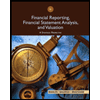 Financial Reporting, Financial Statement Analysis...FinanceISBN:9781285190907Author:James M. Wahlen, Stephen P. Baginski, Mark BradshawPublisher:Cengage Learning
Financial Reporting, Financial Statement Analysis...FinanceISBN:9781285190907Author:James M. Wahlen, Stephen P. Baginski, Mark BradshawPublisher:Cengage Learning
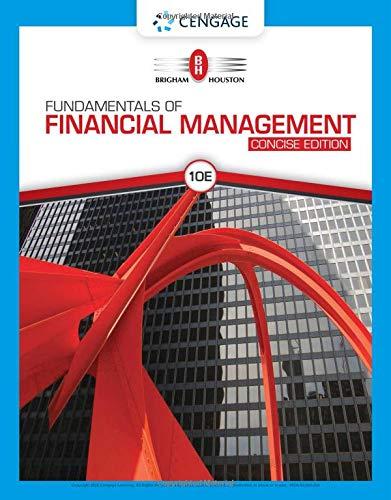 Fundamentals Of Financial Management, Concise Edi...FinanceISBN:9781337902571Author:Eugene F. Brigham, Joel F. HoustonPublisher:Cengage Learning
Fundamentals Of Financial Management, Concise Edi...FinanceISBN:9781337902571Author:Eugene F. Brigham, Joel F. HoustonPublisher:Cengage Learning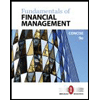 Fundamentals of Financial Management, Concise Edi...FinanceISBN:9781305635937Author:Eugene F. Brigham, Joel F. HoustonPublisher:Cengage Learning
Fundamentals of Financial Management, Concise Edi...FinanceISBN:9781305635937Author:Eugene F. Brigham, Joel F. HoustonPublisher:Cengage Learning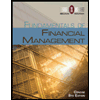 Fundamentals of Financial Management, Concise Edi...FinanceISBN:9781285065137Author:Eugene F. Brigham, Joel F. HoustonPublisher:Cengage Learning
Fundamentals of Financial Management, Concise Edi...FinanceISBN:9781285065137Author:Eugene F. Brigham, Joel F. HoustonPublisher:Cengage Learning Intermediate Financial Management (MindTap Course...FinanceISBN:9781337395083Author:Eugene F. Brigham, Phillip R. DavesPublisher:Cengage Learning
Intermediate Financial Management (MindTap Course...FinanceISBN:9781337395083Author:Eugene F. Brigham, Phillip R. DavesPublisher:Cengage Learning





